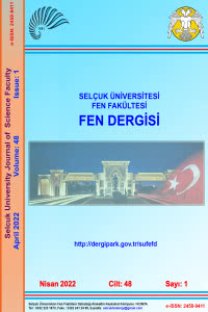LiBr-H2O AKIŞKAN ÇİFTİNİ KULLANAN BİR ABSORBSİYONLU SOĞUTMA SİSTEMİ İÇİN TERMODİNAMİK VE EKSERJİ ANALİZİ
Thermodynamic and Exergy Analysis of an Absorption Cooling System for Libr-H2O Fluid Couple
___
- Abdulateef, J. M., Sopian, K., Alghoul, M. A., Sulaiman, M. Y., Zaharim, A., & Ahmad, I., 2007, “Solar absorption refrigeration system using new working fluid pairs”, International Journal of Energy, Vol. 1, No. 3, pp. 82-87
- Alamdari, G. S., 2007, “Simple functions for predicting the thermodynamic properties of ammonia-water mixture”, Internatıonal Journal of Engineering-Materials And Energy Research Center, Vol.20, No. 1, pp. 95-104.
- Anusha, B., Chaitanya, B., 2017, “Performance Analysis of Absorption Refrigeration Cycles”, International Journal of Advanced Engineering Research and Science, Vol. 4, No. 1.
- Azhar, M., Siddiqui, M. A., “Energy and Exergy Analyses for Optimization of the Operating Temperatures in Double Effect Absorption Cycle”, Energy Procedia Vol. 109, pp. 211-218.
- Bhaumik, M., Mudgal, A., Bhavesh, P., 2017, “Energy and exergy investigation of small capacity single effect lithium bromide absorption refrigeration system”, Energy Procedia, Vol. 109, pp. 203-210.
- Bouaziz, N., Lounissi, D., 2015, “Energy and exergy investigation of a novel double effect hybrid absorption refrigeration system for solar cooling”, International journal of hydrogen energy, Vol. 40 , No. 39, pp. 13849-13856.
- Bourseau, P., Bugarel, R., 1986, “Absorption-Diffusion Machines: Comparison of the Performances of NH3-H2O and NH3-NaSCN”, International Journal of Refrigeration, Vol. 9, pp. 206-214.
- Dehua, C., Guogeng, H., Qigi, T.,Weier, T., 2014, “Exergy analysis of a novel air-cooled non-adiabatic absorption refrigeration cycle with NH3–NaSCN and NH3–LiNO3 refrigerant solutions”, Energy Conversion and Management, pp. 66-78.
- Farshi, L. G., Ferreira, C. I., Mahmoudi, S. S., Rosen, M. A., 2014, “First and second law analysis of ammonia/salt absorption refrigeration systems”, International journal of refrigeration, Vol. 40, pp. 111-121.
- Ferreira, I., 1984, “Thermodynamic and Physical Property Data Equations for Ammonia-Lihtium Nitrate and Ammonia-Sodium Thiocyanate Solutions”, Solar Energy, Vol. 32, No. 2, pp. 231-236.
- Florides, G., Kalogirou, S., 2003, “Design and Construction of a LiBr–Water Absorption Machine”, Energy Conversion And Management, Vol. 44, pp. 2483-2508.
- Ganesh, N. S., Srinivas, T., 2011, “Evaluation of thermodynamic properties of ammonia-water mixture up to 100 bar for power application systems”, Journal of mechanical engineering research, Vol. 3, No. 1, pp. 25-39.
- Garousi, F. L., Infante, F. C., Mahmoudi, S.,Rosen, M., 2014, “First and second law analysis of ammonia salt absorption refrigeration systems”, International Journal Of Refrigeration, Vol. 40, pp. 111-121.
- Lavinia, G., Dobrovicescu, A., Untea, A., 2014, "Energy and exergy analyses of a solar-driven absorption cooling system", International Journal of Exergy, Vol. 15, No. 3, pp. 308-327.
- Kaita, Y., 2001, “Thermodynamic properties of lithium bromide–water solutions at high temperatures”, International Journal of refrigeration, Vol. 24, No. 5, pp. 374-390.
- Kaushik, S., Arora, A., 2009, “Energy and Exergy analysis of single effect and series flow double effect water lithium bromide absorption refrigeration systems”, International Journal of Refrigeration, Vol. 32, pp. 1247-1258.
- Linghui, Z., Junjie, G., 2010, “Second law based thermodynamic analysis of ammonnia sodium thiocyanate absorption system”, Renewable Energy, pp. 1940-1946.
- Patek, J. P., Klomfor, J., 1995, “Simple Functions for Fast Calculations of Selected Thermodynamic Properties of the Ammonia-Water System”, Int.J.Refring, Vol.4, No. 18, pp. 228-234.
- Patel, H. A., Patel, L. N., Jani, D., Christian, A., 2016, “Energetic Analysis of Single Stage Lithium Bromide Water Absorption Refrigeration System”, Procedia Technology, Vol. 23, pp. 488-495.
- Urueta, G. G. , Huicochea, A., Aumente, P. R., Rivera, W., 2014, “Energy and exergy analysis of waterLiBr absorption systems with adiabatic absorbers for heating and cooling”, Energy Procedia, Vol. 57, pp. 2676-2685.
- Urueta, G. G., Huicochea, A., Rivera, W., Aumente, P. R., & Oviedo-Tolentino, F., 2017, “Experimental energy and exergy analysis of a novel water-LiBr absorption system”, International Journal of Exergy, Vol. 23, No. 1, 31-46.
- Touaibi, R., Feidt, M., Vasilescu, E. E., Abbes, M. T., 2013, “Parametric study and exergy analysis of solar water–lithium bromide absorption cooling system”, International Journal of Exergy, Vol. 13, No. 3, pp. 409-429.
- Yağcıoğlu, K. Ç., 2018, Absorbsiyonlu Bir Soğutma Sisteminde Farklı Soğutucu Akışkanlar için Termodinamik ve Ekserji Analizi, Master Thesis, Necmettin Erbakan Üniversitesi Fen Bilimleri Enstitüsü.
- ISSN: 2147-9364
- Yayın Aralığı: 2
- Başlangıç: 2013
- Yayıncı: Selçuk Üniversitesi Mühendislik Fakültesi
ARKLI BAĞLANTI YÖNTEMLERİ İLE HİYERARŞİK KÜMELEME TOPLULUĞU
MEME KANSERİ TANISI İÇİN DERİN ÖZNİTELİK TABANLI KARAR DESTEK SİSTEMİ
KÖMÜR FLOTASYONUNDA FARKLI YAĞLARIN PERFORMANSLARININ KARŞILAŞTIRILMASI
Yaşlandırma Süresinin Co-Cr-Mo Alaşımlarının Faz Dönüşümleri, Mikroyapıları ve Sertliğine Etkisi
KOBALT KATKILI ÇİNKO OKSİT NANOPARÇACIKLARIN YAPISAL ÖZELLİKLERİNİN İNCELENMESİ
Güvenç AKGÜL, Funda AKSOY AKGÜL
EFFECT OF ASPECT RATIO ON THE FREEZING-THAWING OF A CH CLAY
R. Kağan AKBULUT, A. Şahin ZAİMOĞLU
PREFABRİKE YAPILARIN RÜZGÂR YÜKÜ GÜVENLİĞİNİN BELİRLENMESİ
Mümüne SERT, Saadettin Erhan KESEN
Engelli Optimal Arama için Yaklaşımsal Dinamik Programlama
APPROXIMATE DYNAMIC PROGRAMMING FOR OPTIMAL SEARCH WITH AN OBSTACLE
